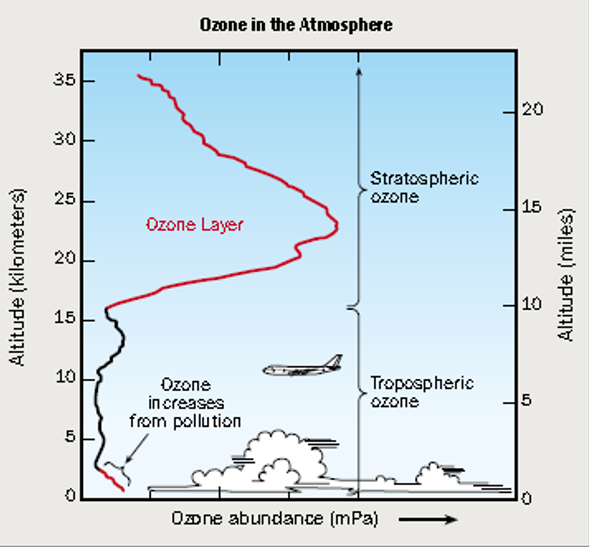- Ozone is responsible for most of the air sickness and symptoms associated with flying, and can cause severe respiratory problems for the crew.
- Ozone damage can oxidize substances in components, reducing their lifetime and compromising the safety of people onboard and on the ground.
- Regulations and recommendations by the FAA exist to limit ozone levels; however, actual cabin ozone levels can still exceed permitted levels.
Ozone in the stratosphere is crucial for life as it protects Earth from harmful UV radiation. However, it is also a pollutant and health risk when in proximity to people and machines. Aircraft and other aerospace vehicles that reach atmospheric heights where ozone concentrations are high are at risk from their considerable negative impacts. In this article, we will discuss the effects of ozone on aircraft and the gaps that still exist in its control.
Health Effects on Passengers

Figure 1: “Ozone is present throughout the troposphere and stratosphere. Most ozone resides in the stratospheric ozone layer, “EPA. (Image credits: https://www.epa.gov/ozone-layer-protection/basic-ozone-layer-science)
The stratosphere extends between 10 and 50 km above sea level. The ozone layer occurs between 15 and 30 km, where the gas exists in high concentrations, as shown in Figure 1. Several commercial aircraft fly at this height in an ozone-rich atmosphere. Ozone can enter the aircraft, including commercial flights, through the air conditioning system, affecting both people and the vehicle’s components.
Ozone (O3) is a health hazard if people breathe air containing it. The seriousness of the effects depends on the gas’s concentration, as well as exposure duration and frequency. The gas results in many of the symptoms associated with air travel, such as jet lag, air sickness, headaches, eye, throat, and nose irritation, fatigue, breathing problems, coughing, and chest pain. Exposure to higher concentrations can lead to pulmonary edema or fluid buildup in the lungs.
Cabin crew members who have repeated exposure to ozone can suffer from asthma aggravation, the development of asthma, and lung damage.
In general, people with asthma, the elderly, and children are at greater risk from ozone’s health effects.
The fat and oil produced by humans increase body interaction with ozone, which is very reactive. Ozone reacts with fatty acids, cholesterol, and other compounds to produce aldehydes, which are also irritants and can affect people. Scientists call this the “Pig-Pen Effect.” The skin oil rubs off onto seats and is absorbed by the textile, increasing “Pig-Pen” pollution around seats and affecting all people on board.
Airplane Components
Ozone’s high reactivity can also affect many aircraft components. Component materials play a crucial role in ensuring the safety and performance of aircraft.
Ozone is an unstable compound that decomposes to oxygen by reacting with nearly all substances, including organic compounds, metals, rubber, and plastics. The substances undergo oxidation, and the resulting damage can reduce the effectiveness, performance, and lifespan of the components, potentially leading to leaks and even complete system failure, which can endanger people and aircraft.
Gaskets, seals, rubber, fluorocarbons, and even stainless steel are aircraft components commonly affected by the ozone-rich stratosphere.
- Seals and gaskets are usually made of rubber. Ozone reacts with the rubber polymer chains, oxidizing and breaking the bonds that hold them, leading to cracks. Ozone also causes dryness, brittleness, and deterioration in rubber.
- Polymers and coatings are commonly used because they are lightweight, durable, and resistant to corrosion. However, ozone can cause micro-cracking, which, under mechanical stress, can grow larger, affecting structural integrity and reliability.
- After gaskets are compromised, the ozone can also attack stainless steel and galvanized parts.
Factors such as material composition, temperature, ozone concentration, and exposure duration will determine a component’s resistance to ozone. Careful inspection to remove and replace damaged components is crucial to ensure the safety of both people and vehicles.
Regulations to Control Cabin Ozone Levels
In 1980, the Federal Aviation Administration (FAA) limited cabin ozone levels to mitigate their damage after aircraft crew members reported experiencing respiratory problems and headaches. The minimum standards for cabin ozone concentration as stipulated in 14CFR 25.832 and AC 120-38 are as follows:
- Less than 0.25 parts per million (ppm), sea level equivalent, at any given time, above the Flight Level 320 (32,000 feet).
- An average of 0.1 ppm, sea level equivalent, during any 3-hour interval for flights above Flight Level 270 (27,000 feet), that last longer than four hours.
- AC 120-38 also stipulates that cabin ozone levels in flights above 18000 feet should not be over 0.25 ppm at any time. Ozone levels must also be below an average of 0.1 ppm for flights over four hours.
These rules do not apply to commercial flights with a duration of less than four hours. The regulations also only apply to flights with passengers, not to aircraft with only crew, such as cargo flights.
The U.S. Occupational Safety and Health Administration (OSHA) has no jurisdiction over employee exposure while in flight; however, following its recommendations can help keep crew and passengers safe.
- OSHA recommendations for ozone exposure include a permissible exposure limit (PEL) of 0.1 ppm for an 8-hour time-weighted average (TWA) and a short-term exposure limit (STEL) of 0.3 ppm for 15 minutes.
- The National Institute for Occupational Safety and Health (NIOSH) requires ozone levels to be maintained below 0.1 ppm at all times. The immediately dangerous to life or health (IDLH) levels are set at five ppm.
- The American Conference of Governmental Industrial Hygienists (ACGIH) has set threshold limit values (TLVs) based on the nature of work:
- TLV for heavy work for an 8-hour TWA is 0.05 ppm
- TLV for moderate work for an 8-hour TWA is .08 ppm
- TLV for light work for an 8-hour TWA is 0.1 ppm
- TLV for exposures to any work for less than two hours is 0.2 ppm
Cabin crew can fly multiple flights in a day, and their average ozone exposure can exceed OSHA limits even if each flight complies with FAA standards. So, cabin crew could be exposed to more ozone than workers in any other industry, while owners are still technically in compliance.
Remedial Measures
The FAA also published an Advisory Circular (AC), AC 120-38, to guide air carriers on how to comply with the FAA ozone standards. The AC recommended catalytic converters and ozone filters to keep ozone concentrations below the permitted levels. The device is installed in the ducting, which converts ozone to oxygen, before the air enters the cabin. The AC has also stipulated requirements for the cleaning and replacement of catalytic converters to extend the lifespan of air-conditioning units and aircraft components, thereby reducing risks to people on board.
Compliance with Ozone Regulations
Air carriers are required to show that the ozone levels in their aircraft do not exceed levels set by the FAA based on the filter or catalytic converter manufacturer’s efficiency data. However, manufacturers use AC 120-38’s ozonesonde data or equivalent outdated data sets. Due to the gaps in FAA regulations, even compliance does not eliminate ozone from cabins. The actual ozone levels in the cabin are over permitted FAA levels.
Air carriers are also not required to monitor actual ozone levels in the cabin continuously. Additionally, the FAA regulations, which remain in effect, do not account for the cumulative impact of cabin crews’ exposure to ozone over multiple flights, including non-passenger flights.
According to scientists from Embry-Riddle Aeronautical University, a review and revision of FAA regulations are overdue to address these gaps and ensure flights are healthy and safe for both crew and passengers.
Instruments to Monitor Ozone
Precision devices that can measure trace amounts of ozone already exist on the market. Interscan offers several sensors that can be used for continuous and spot monitoring of air ozone. The sensitive sensors have a measuring range of 0-2000 ppb, with a resolution of < 0.03 ppm. These sensors can detect ozone levels of 0.1 ppm and above, in compliance with FAA and OSHA regulations. Although air monitoring is not mandatory, it may be advisable to use sensors to detect ozone levels above permitted limits, thereby prolonging the lifespan and effectiveness of the components and ensuring the safety of people and aircraft.
Contact us at Interscan to find out how we can help keep your aircraft safe.
Sources
ACS. (n.d.). When a Good Relationship Turns Toxic: Ozone On Airplanes. Retrieved from https://www.acs.org/catalyzing-change/when-a-good-relationship-turns-toxic-ozone-on-airplanes.html
Cable, J. (2011, April). How Ozone Affects Passengers & System Components. Retrieved from https://www.duncanaviation.aero/intelligence/how-ozone-affects-passengers-system-components
EPA.Gov. (2025, March 5). Basic Ozone Layer Science. Retrieved from https://www.epa.gov/ozone-layer-protection/basic-ozone-layer-science
EPA.Gov. (2025, March 11). Health Effects of Ozone Pollution. Retrieved from https://www.epa.gov/ground-level-ozone-pollution/health-effects-ozone-pollution
Eurolab. (n.d). Assessing ozone-induced cracking in aerospace polymers and coatings. Retrieved from https://www.testinglaboratory.org/assessing-ozone-induced-cracking-in-aerospace-polymers-and-coatings
Nazaroff, W.W., and Weschler, C.J. (2010, Aug). Ozone in Passenger Cabins: Concentrations and Chemistry. Retrieved from https://www.faa.gov/sites/faa.gov/files/data_research/ research/med_humanfacs/cer/OzonePassengerCabins.pdf
- Gov (2003). Hazardous Substances Fact Sheet –Ozone. Retrieved from https://nj.gov/health/eoh/rtkweb/documents/fs/1451.pdf
Pottinger, T.L. & Marcham, C.L. (2018). An Analysis of Cabin Ozone Regulation. Collegiate Aviation Review International, 36(2), (pending). Retrieved from http://ojs.library.okstate.edu/osu/index.php/CARI/article/view/7729
Science Direct. (n.d.). Ozone Crack. Retrieved from https://www.sciencedirect.com/topics/engineering/ozone-crack
Wei, Y., & Fang, Z. (2019). Ozone Pollution: A Major Health Hazard Worldwide. Frontiers in Immunology, 10, 2518. https://doi.org/10.3389/fimmu.2019.02518
Code of Federal Regulations. (2025, June 17). § 25.832 Cabin ozone concentration. Retrieved from https://www.ecfr.gov/current/title-14/chapter-I/subchapter-C/part-25/subpart-D/subject-group-ECFR99abb8c7d4bf678/section-25.832


